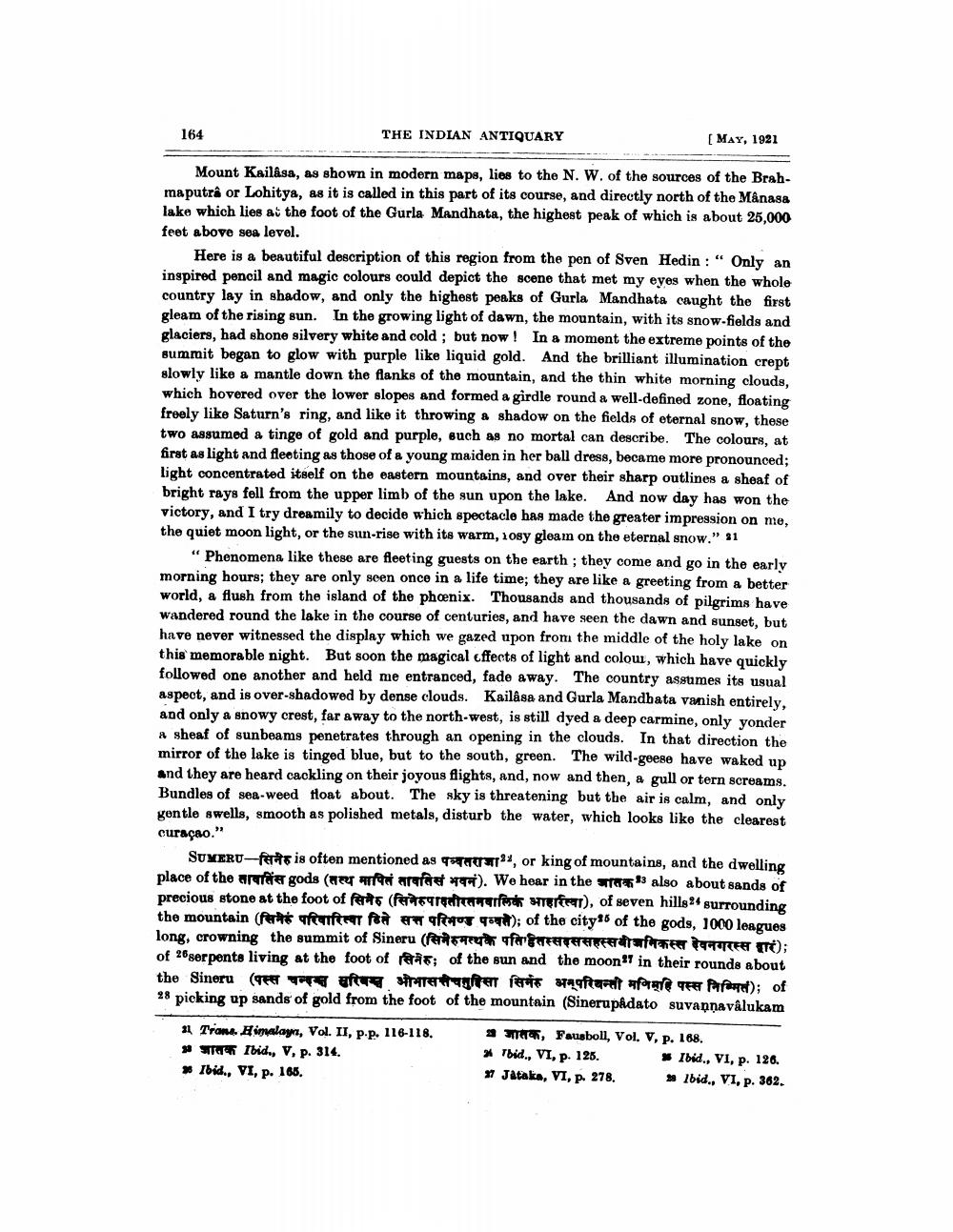________________
164
THE INDIAN ANTIQUARY
Mount Kailasa, as shown in modern maps, lies to the N. W. of the sources of the Brahmaputra or Lohitya, as it is called in this part of its course, and directly north of the Mânasa lake which lies at the foot of the Gurla Mandhata, the highest peak of which is about 25,000 feet above sea level.
[ MAY, 1921
Here is a beautiful description of this region from the pen of Sven Hedin: "Only an inspired pencil and magic colours could depict the scene that met my eyes when the whole country lay in shadow, and only the highest peaks of Gurla Mandhata caught the first gleam of the rising sun. In the growing light of dawn, the mountain, with its snow-fields and glaciers, had shone silvery white and cold; but now! In a moment the extreme points of the summit began to glow with purple like liquid gold. And the brilliant illumination crept slowly like a mantle down the flanks of the mountain, and the thin white morning clouds, which hovered over the lower slopes and formed a girdle round a well-defined zone, floating freely like Saturn's ring, and like it throwing a shadow on the fields of eternal snow, these two assumed a tinge of gold and purple, such as no mortal can describe. The colours, at first as light and fleeting as those of a young maiden in her ball dress, became more pronounced; light concentrated itself on the eastern mountains, and over their sharp outlines a sheaf of bright rays fell from the upper limb of the sun upon the lake. And now day has won the victory, and I try dreamily to decide which spectacle has made the greater impression on me, the quiet moon light, or the sun-rise with its warm, 10sy gleam on the eternal snow." 21
"Phenomena like these are fleeting guests on the earth; they come and go in the early morning hours; they are only seen once in a life time; they are like a greeting from a better world, a flush from the island of the phoenix. Thousands and thousands of pilgrims have wandered round the lake in the course of centuries, and have seen the dawn and sunset, but have never witnessed the display which we gazed upon from the middle of the holy lake on this memorable night. But soon the magical effects of light and colour, which have quickly followed one another and held me entranced, fade away. The country assumes its usual aspect, and is over-shadowed by dense clouds. Kailasa and Gurla Mandhata vanish entirely, and only a snowy crest, far away to the north-west, is still dyed a deep carmine, only yonder a sheaf of sunbeams penetrates through an opening in the clouds. In that direction the mirror of the lake is tinged blue, but to the south, green. The wild-geese have waked up and they are heard cackling on their joyous flights, and, now and then, a gull or tern screams. Bundles of sea-weed float about. The sky is threatening but the air is calm, and only gentle swells, smooth as polished metals, disturb the water, which looks like the clearest curaçao."
SUMERU-fer is often mentioned as q, or king of mountains, and the dwelling place of the तावसिंस gods (तत्थ मापितं तावतिसं भवनं). We hear in the जातक also about sands of precious stone at the foot of सिनेह (सिनेहपादतीरतनवालिक आहारत्वा), of seven hills 24surrounding the mountain (fertis aftanfter fe ft); of the city15 of the gods, 1000 leagues long, crowning the summit of Sineru (सिनेरुमत्थके पति द्वैतस्सदससहस्सयोजनिकस्स देवनगरस्स द्वार); of 26serpents living at the foot of s; of the sun and the moon in their rounds about the Sineru (पल्स चन्दन्स सरिबन्स ओभासतेचतुहिसा सिनेह अम्परियन्ती मनिमहि पस्स निम्मित); of 28 picking up sands of gold from the foot of the mountain (Sinerupâdato suvanṇavâlukam
11 Trans. Himalaya, Vol. II, p.p. 116-118. 23 Ibid., V, p. 314.
Ibid., VI, p. 165.
2, Fausboll, Vol. V, p. 168.
2 Tbid., VI, p. 125.
27 Jataka, VI, p. 278.
Ibid., VI, p. 126. 2 lbid., VI, p. 362.




